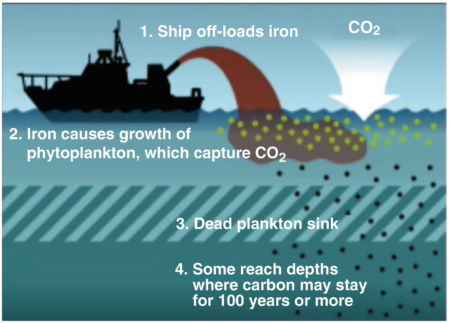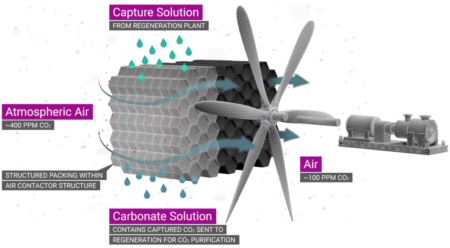July 19, 2019 – In Part 1 of this series posted yesterday I described two of the more popular geoengineering ideas being bandied about in academia these days: solar radiation management by satellite, and upper atmosphere aerosol release. In Part 2 we look at two more geoengineering ideas and their merits including:
- Direct capture of carbon in the atmosphere
- Seeding the oceans
Direct Carbon Capture from the Atmosphere
Back in 2015, I described the work of Carbon Engineering, a Canadian company backed by Bill Gates, of Microsoft fame, and Murray Edwards, an oil sands magnate. A project that began its life at Harvard University and the University of Calgary. At the time of the first launch of a pilot project in Squamish, British Columbia, the Direct Air Capture or DAC carbon dioxide (CO2) extraction cost was as much as $1,000 USD per ton, ten times more than what was seen as the break-even point to make the technology viable. But now after more than three years of operation, DAC costs per ton are approaching the $100 break-even point.
And what makes the DAC solution even more interesting is that the CO2 is being converted by an air-to-fuel process to become an alternative to gasoline and diesel, capable of being used in existing internal combustion engines on the road today. The cost of this fuel today is 25% more than conventional gasoline and diesel, but with scale could become cost-competitive.
Carbon Engineering isn’t the only DAC technology. Climeworks AG, a Swiss company, launched in 2009, has developed a competing solution to capture atmospheric carbon directly and fixing it permanently underground in basaltic rock turning it into stone in a few years. The company currently has installations in Italy, Iceland, and Switzerland.
These two companies could make it possible for the nations of the world to continue to use fossil fuels for energy if their technologies are replicated by the thousands. One would think that the fossil fuel companies would be knocking on their doors to invest.
Seeding the Oceans
A consequence of increased CO2 and methane (CH4) in the atmosphere means the largest natural carbon sink on the planet is being stressed. I’m talking about the world’s oceans which today play a key part in the normal carbon cycle of our planet. In fact, the oceans have absorbed between one-quarter and one-half of the CO2 we humans have produced since the dawn of the Industrial Revolution. And they are continuing to absorb carbon even if we were to go to net zero emissions globally today. Scientists estimate that the legacy of current atmospheric carbon will continue to impact the world’s oceans for at least the next two centuries before the trend gets reversed.
What happens when the oceans absorb carbon? The CO2 combines with water to create carbonic acid which alters the acid-base pH balance. If enough carbon is absorbed it means the animals that require exoskeletons and shells for survival are threatened. It means shellfish, corals, and many other species are at increased risk. And it means the base of the ocean food chain, coccolithophores, a form of plankton and a food source for small fish and zooplankton are at risk as well. To describe the danger as an extinction-level event throughout the entire ocean food chain is not too far off base. We may find ourselves lucky with some forms of plankton that can adapt to changes in pH balance in our oceans, but we have no idea what will ensue as acidity increases. Can the base of the ocean food chain adapt to a more acidic ocean world? Or should we be intervening to counterbalance the increased acidification?
In October 2012, Russ George, an American decided to dump 100 tons of iron sulfate into the oceans off the British Columbia coast covering an area of 10,000 square kilometers (3,861 square miles). The goal was to create an oceanic algae bloom that would then absorb CO2 and when it died, would sink to the seafloor where the carbon would be permanently sequestered. At the time research from the University of Sydney discounted the value of such activities noting that the cost to make the iron in terms of carbon emissions was greater than the carbon savings that would be derived.
George isn’t the only one who has been thinking along these lines. Before him, a joint project of the Indian and German governments in 2009 dumped six tons of iron sulfate off the coast of Argentina. And even prior to that date some 12 iron-enrichment experiments were carried out up until the year 2005. More recently there is the Korea Polar Research Institute which has funded iron fertilization experiments off Antarctica. And Chile’s Oceanos Marine Research Foundation has also dumped iron off its coast in 2018.
What kind of scale would be needed to raise the oceans pH levels by 0.1 to restore them to levels more friendly to carbonate dependent ocean life? One study says the area of coverage would have to be equal to twice the Earth’s surface done every year.
One other consequence of iron fertilization of the ocean is the impact it will have on levels of oxygen in seawater. When algae bloom and die it deoxygenates the surrounding water. Thus iron fertilization on a global scale could produce an extinction event for much of life in the world’s oceans.
The unintended consequences of experiments of this type are fearful to contemplate.
In Part 3 of this series on geoengineering, we will conclude with a look at current thoughts and experiments to stop polar ice melt, and the building of green walls, afforestation, and reforestation projects, all in the name of offsetting anthropogenic carbon contributions.










